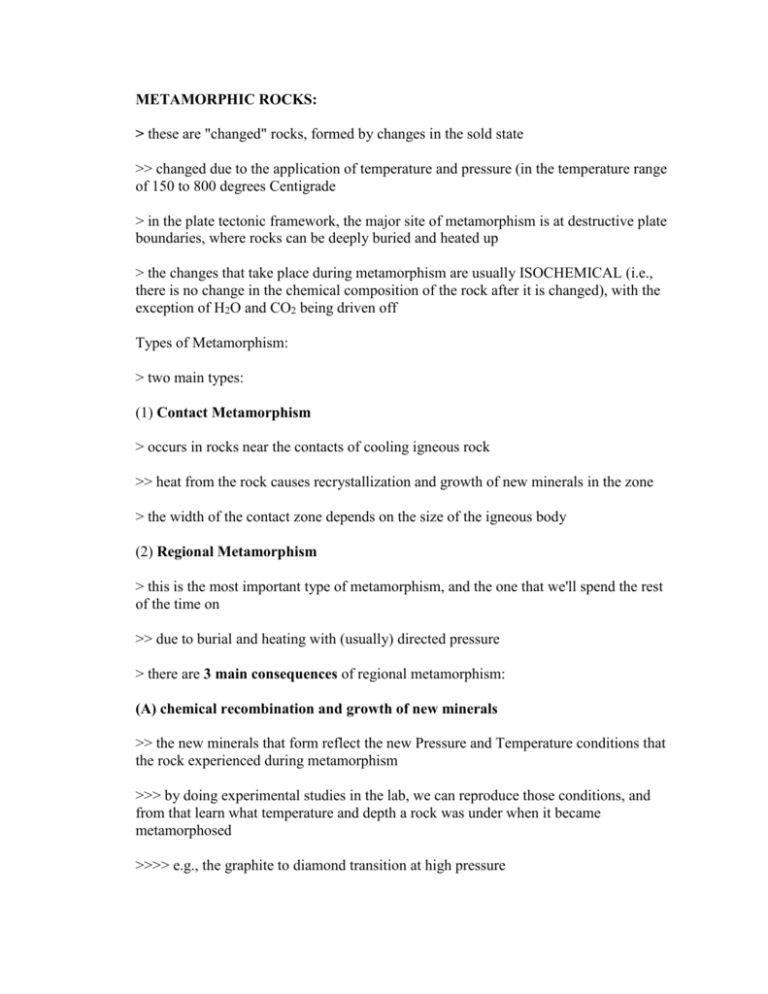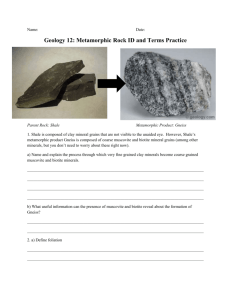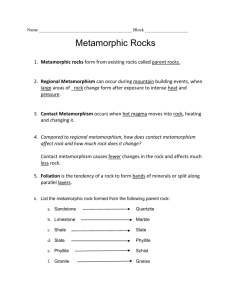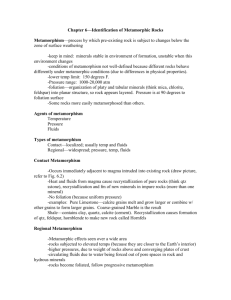12. Metamorphic Rocks
advertisement

METAMORPHIC ROCKS: > these are "changed" rocks, formed by changes in the sold state >> changed due to the application of temperature and pressure (in the temperature range of 150 to 800 degrees Centigrade > in the plate tectonic framework, the major site of metamorphism is at destructive plate boundaries, where rocks can be deeply buried and heated up > the changes that take place during metamorphism are usually ISOCHEMICAL (i.e., there is no change in the chemical composition of the rock after it is changed), with the exception of H2O and CO2 being driven off Types of Metamorphism: > two main types: (1) Contact Metamorphism > occurs in rocks near the contacts of cooling igneous rock >> heat from the rock causes recrystallization and growth of new minerals in the zone > the width of the contact zone depends on the size of the igneous body (2) Regional Metamorphism > this is the most important type of metamorphism, and the one that we'll spend the rest of the time on >> due to burial and heating with (usually) directed pressure > there are 3 main consequences of regional metamorphism: (A) chemical recombination and growth of new minerals >> the new minerals that form reflect the new Pressure and Temperature conditions that the rock experienced during metamorphism >>> by doing experimental studies in the lab, we can reproduce those conditions, and from that learn what temperature and depth a rock was under when it became metamorphosed >>>> e.g., the graphite to diamond transition at high pressure >>>> e.g., at 575 degrees Centigrade and 6 kilobars (i.e., ca. 20 Km deep), KAL2 (AlSi3O10 ) (OH)2 (muscovite mica) + SiO2 (quartz) goes to KALSi3O8 (K-feldspar) + Al2 SiO5 (kyanite) + H2O (Note: when a metamorphic rock that formed deep in the earth under high temperature and pressure is brought back to surface by erosion of the overlying rocks, it can maintain the metamorphic minerals because the water has been driven off, and the reaction rates are very slow then) (B) recrystallization of minerals into larger grains > for example, think of how coarse the calcite crystals are in marble compared to the microcrystalline calcite in the limestone it formed from; or think of the garnet-muscovite schist that formed from a shale with clay-sized particles (C) rotation and growth of platy minerals (e.g., mica, chlorite, etc.) > this creates an alignment of platy minerals, or colour bands, at right angles to the squeezing direction >> we call this alignment a FABRIC (or a FOLIATION) Classification of Regional Metamorphic Rocks (1) The main criterion for the naming of metamorphic rocks is the FOLIATION STATE > this is because it reflects the degree, or intensity, of metamorphism > for example, a shale would, with increasing metamorphism, go through the following stages: shale > slate > schist > gneiss >> a slate has the re-alignment of old platy minerals, and growth of new platy minerals, at right angles to the squeezing direction; the minerals are still microscopic, but the rock develops a tendency to split along this foliation direction (slaty fracture) >> in the schist, the platy minerals (e.g., muscovite) are coarse enough to be seen with the unaided eye, and their alignment can give the rock a sheen; big crystals such as garnet or andalusite can form >> in a gneiss, the temperatures were so high that ions could move around over large distances (up to several cm), with the development of dark (mafic-rich) and light (felsic-rich) bands (a gneissic fabric, or gneissic foliation) >> in a gneiss heated up to the point of the beginning of melting, the first liquid to form will be a granite in composition (remember Bowen's Reaction Series), and this can lead to the formation of thin granite bands in the gneiss (we call such a rock a migmatite) (2) a secondary criterion in the naming of metamorphic rocks is CHEMICAL COMPOSITION > since metamorphism is essentially isochemical, the chemical composition of the metamorphic rock gives us a clue to the original composition of the rock, and hence an idea of what kind of rock it had been (i.e., the composition reflects the starting material) >> for example, to call a rock a gneiss just tells us it was transformed under a high grade of metamorphism (high T and P), but not what the rock had been. Thus, you add the extra words, such as quartz-feldspar gneiss (suggesting that it might have been a shale originally), or amphibolite gneiss (to suggest that it might have been a basalt or gabbro originally) >> for two regional metamorphic rocks, we ONLY use the chemical composition to name them: these are marble (formerly a limestone) and quartzite (formerly a quartz sandstone) >>> we can't use foliation state for these two because they are each composed of only one mineral (calcite in marble; quartz in quartzite), and so dark and light colour bands can't form. And those two minerals aren't platy and so no alignment can occur Metamorphism and Bulk Properties > the foliation direction in regional metamorphic rocks becomes a plane of weakness when the rocks are brought to surface >> unloading generally will produce joints along this direction Last revision: 13 November 2000 These pages and their contents are Copyright © of the Department of Geological Sciences, Queen's University 20002001 (except as noted). If you have any problems with this web service, Email badham@geol.queensu.ca Back to APSC151 Course Notes Page










